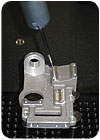
Nathan Corliss, assistant quality manager at Seiler Instruments and Manufacturing, measures a military part on the Contura G2 using a Vast XXT scanning sensor. Source: Carl Zeiss
Seiler Instruments and Manufacturing (St. Louis) is a contract manufacturer, specializing in fire-control equipment, as well as a distributor of surveying instruments, microscopes and Zeiss planetaria.
“Our primary customer, the U.S. military, is very stringent on documentation and product verification. Although not explicitly required, our customers are happy to see sophisticated and automated equipment verifying their product. Some of the instruments are used overseas to support our troops and the product must be accurate,” says Nathan Corliss, assistant quality manager at Seiler Instruments.
For Corliss, seeing first-hand the benefits of owning an automated coordinate measuring machine (CMM) was a strong motivator in sticking with and purchasing more CMMs from Carl Zeiss (Maple Grove, MN) for their manufacturing plant.
Seiler Instruments purchased their first Zeiss CMM, a Vista, in 2006. After experiencing the reliability and accuracy of the Vista, they quickly moved forward in purchasing a Contura G2 with a Vast XXT scanning sensor in 2008.
“Carl Zeiss is known for building the finest equipment in multiple fields and was the obvious choice when entering into the automated CMM arena. The technology and Calypso software were unknown to us until the Vista. Once we saw the benefits and advantages, we invested in the more advanced Contura G2 which met our manufacturing needs perfectly,” says Corliss.
The Contura G2, with the articulating RDS and XXT, is designed for measuring complex features and parts with multiple angles that require very small styli, which is an ideal CMM for Seiler Instruments.
The Zeiss CMMs operate in the middle of an environmentally controlled manufacturing plant, supporting in-process inspection. “We are measuring a variety of different parts from large machined castings to small screw machine style parts. We produce parts for optical assemblies for the U.S. military, primarily fire control instruments for artillery weapons. The CMMs are used in the middle of the manufacturing plant to aid in the setup and in process inspection of the parts,” says Corliss.
Enhancing the reliability
Having the correct CMM and software is key to complete accuracy inspection capabilities. “There were things the Contura G2 with the Vast XXT scanning sensor was seeing that couldn’t be detected with our previous inspection capabilities,” Corliss explains.For example, the assembly was having difficulty with a gear produced from an outside vendor. They determined their process changes were causing the error. “Once they went back to the old process, the scanning characteristics began to show favorable results and the product worked,” Corliss says.
It is not uncommon for Seiler Instruments to target tolerances of 0.0003 inch, which means ensuring the CMM can do the job. On a typical day, a machinist will set up their machining center and cut a setup piece. Complex parts will be brought to the CMMs for verification and set up adjustments before going into production.
When asked how lean manufacturing and measuring instruments from Carl Zeiss fit into their process, Corliss responds, “Using the CMMs has reduced setup times on several complex parts. Many parts have well over 100 dimensions and would take up to a whole shift to prove out before production could commence. Many parts were reduced from seven hours of surface plate work to one hour total inspection time.”

Shown is a close-up of a Seiler Manufacturing base component being measured by the Vast XXT sensor. Source: Carl Zeiss
Above and Beyond
It is important in any industry to maintain accuracy, but when dealing with the U.S. military it is crucial to maintain quantifiable results and reliability on all parts and equipment manufactured.When asked about any surprises or quantifiable results, Corliss says, “The Contura G2 has discovered issues that were difficult to find with standard inspection methods. This has helped improve our processes, our vendors’ processes and the overall quality. Our assembly managers have indicated parts are going together better. The machinists are dedicated to producing high quality parts and have used the information to tweak and adjust processes to achieve better results. The Contura G2 has also validated parts conforming to requirements which were difficult to prove out before.”
In the manufacturing industry, it is crucial to learn from quality review inspections and to help others who may also be experiencing similar issues or problems. Seiler Instrument has done a thorough job in both analyzing and learning from their results.
“The scanning capabilities of the Contura G2 and Calypso’s ability to create valuable form plots have helped improve our internal and vendor processes. We try to understand why the CMMs are generating the result so we can provide useful feedback to the manufacturing areas,” Corliss points out. “It is important for all CMM programmers and operators to understand how and why the results are generated. I’m not saying you shouldn’t trust your equipment, but understand that a speck of dirt, fixturing method or bad CNC [computer numerical control] alignment can lead to results that might not be accurate.”
Asked what two things best describe his experience using and owning a Carl Zeiss CMM, Corliss states, “Carl Zeiss provides a Calypso forum on their Web site for users to share ideas. At times, Zeiss application engineers periodically check the forum and provide input. Carl Zeiss also hosts annual conferences and a North American user group to solicit customer feedback and provide training opportunities. Overall, the systems have been reliable and provide increased credibility with our customers. It has helped improve our internal and vendor quality.”
Carl Zeiss
(763) 744-2409
www.zeiss.com/imt
Reply 11